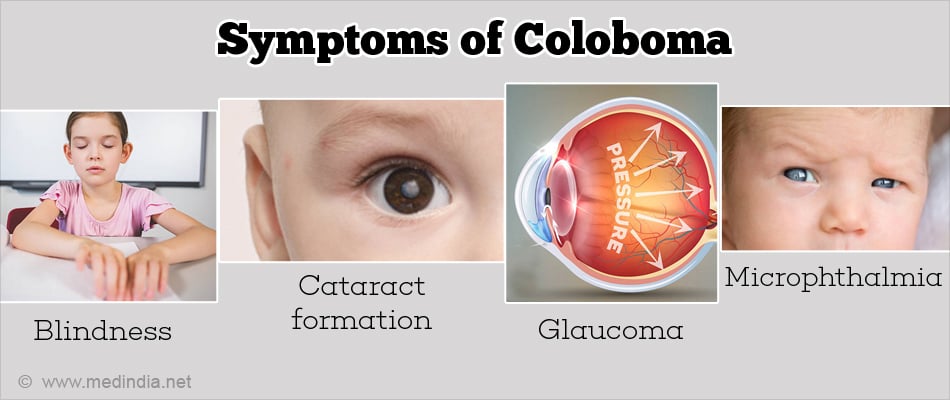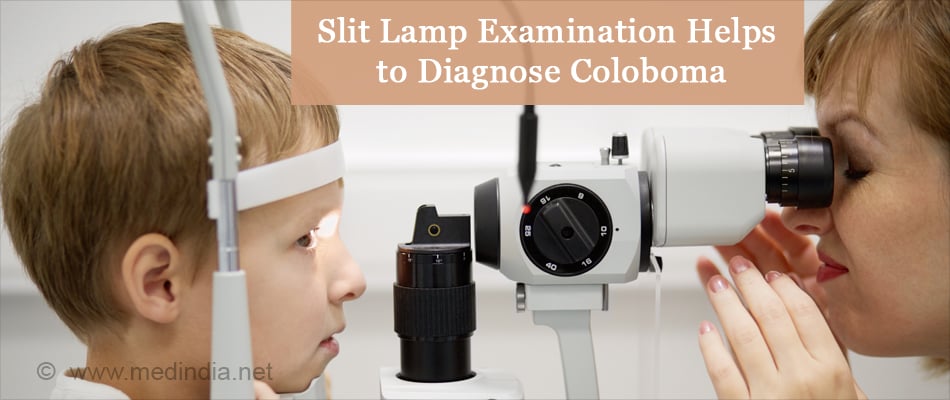- What is a coloboma? - (https://www.aapos.org/terms/conditions/35)
- Coloboma - (https://ghr.nlm.nih.gov/condition/coloboma)
- What is a Coloboma? - (https://www.aao.org/eye-health/diseases/what-is-coloboma)
- Coloboma - (http://www.rnib.org.uk/eye-health-eye-conditions-z-eye-conditions/coloboma)
What is Coloboma?
A coloboma is a kind of birth defect characterized by a missing piece of tissue in the eye. It can affect any part of the eye and lead to vision problems and vision loss.
The eye is one of the first organs to develop in the embryo. It develops from a structure called the optic vesicle. The lower end of the optic vesicle possesses a groove called the choroidal fissure. This groove allows the entry of blood vessels into the eye. The fissure normally closes by the seventh week of pregnancy. When it fails to close, it leaves a space with missing tissue called a coloboma.
Although coloboma affects around 1 in 10,000 newborns, the frequency is found to be higher in the Indian subcontinent. It can occur in one or both eyes and can cause considerable distress to both, the child and parents. Some cases do not affect vision and may go unnoticed.
What are the Structures that can be affected by Colobomas?
Colobomas are classified based on the part of the eye affected by them.
Eyelid colobomas: These usually involve a part or whole of the upper eyelid, and may be associated with Treacher-Collins syndrome or Goldenhar syndrome.
Lens colobomas: Part of the lens is missing. The zonules (the fibres that anchor the lens in place) are also absent in this area, and so large lens colobomas can be associated with displacements of the lens.
Iris colobomas: Iris colobomas are the most common. A typical iris coloboma occurs in the lower and inner quadrant of the iris, giving the pupil a keyhole appearance. Typical iris colobomas may be isolated, or may be associated with colobomas of the ciliary body, choroid, retina and optic nerve, and may be associated with a small eyeball. Nystagmus may also be present. An atypical coloboma is present in any of the other quadrants of the iris.
Macular coloboma: The macula is a portion of the retina of the eye that is responsible for central vision. In this type of coloboma, the defect lies in the macula causing partial loss of vision.
Retinal coloboma: The retina contains a gap, in this case, again affecting vision.
Optic nerve coloboma: These may occur in isolation or in conjunction with retinal and choroidal colobomas. Vision may be mildly or severely impaired depending on the degree of involvement. Retinal detachments may occur. Optic nerve colobomas may be a part of the CHARGE syndrome. One particular type of coloboma of the optic disc resembles the morning glory flower and hence is termed morning glory syndrome.
A coloboma can affect different structures in both the eyes. So a baby can have two different types of colobomata in the two eyes!

What are the Causes of Coloboma?
Coloboma can occur spontaneously or it can be inherited. When inherited, it can follow either an autosomal dominant (requires a single copy of the abnormal gene) or autosomal recessive (requires two copies of abnormal genes) mode of inheritance, or rarely x-linked inheritance. Genes like the PAX-6 gene have been associated with coloboma.
Colobomas may occur as a part of a genetic syndrome. It is a distinguishing feature of a genetic syndrome called CHARGE, an acronym for
C – Coloboma of the eye
H – Heart defects
A – Atresia of the choanae (posterior nares)
R – Retardation of growth and development
G – Genital abnormalities
E – Ear abnormalities
CHARGE syndrome occurs due to mutations in CHD7 gene on chromosome 8 and is a life threatening syndrome with substantial morbidity.
Other syndromes are also associated with coloboma, for example, cat eye syndrome, renal coloboma syndrome, trisomy 13 and trisomy 18. A number of environmental factors play a crucial role in the development of coloboma. Among these, the most important is ‘Fetal alcohol syndrome’ which occurs in babies born to mothers consuming alcohol during pregnancy. These babies have a high propensity of developing coloboma. Vitamin A also plays a vital role in the embryological development of the eye.
Therefore, deficiency of Vitamin A can also contribute to the formation of coloboma. Intrauterine infections caused by Toxoplasma or Cytomegalovirus (CMV) can lead to coloboma formation. Also, some teratogenic drugs like thalidomide or mycophenolate can contribute to its development.
What are the Symptoms of Coloboma?
Coloboma remains an important cause of childhood visual impairment and blindness.
Lid colobmas if large can lead to exposure keratitis that can lead to scarring and visual impairment.
Sometimes, a small iris coloboma not attached to the pupil can cause duplication of image called ‘ghost’ imaging, thereby blurring the vision.
Colobomas affecting the retina, macula and optic nerve can affect vision or remain asymptomatic throughout life. In some cases, the defect might remain silent in childhood but cause sudden loss of vision in adulthood due to retinal detachment.
Cataract formation, glaucoma and subluxation of the lens are other eye problems that could occur in a patient with a coloboma.
Sometimes a coloboma occurs in association with microphthalmia (small eye). When the coloboma is a part of a syndrome, other clinical features characteristic of the syndrome will also be present.

How do you Diagnose Coloboma?
A detailed pediatric ophthalmologist evaluation is essential to assess the visual loss.
Direct and Indirect Ophthalmoscopy: It helps in checking for the involvement of the chorio-retinal structures.
Slit lamp examination: It is used to visualize the presence and extent of coloboma in the anterior segment of the eye.
Optical Coherence Tomography (OCT): It is an advanced test used to assess chorioretinal colobomata.
CT Scan / MRI Brain: These imaging tests are required to rule out any brain defects that might occur along with a coloboma.

How do you Treat Coloboma?
The treatment of coloboma depends upon the type.
Eyelid coloboma:Surgery in an eyelid coloboma is mainly for cosmesis and corneal protection. If small, then the cornea be protected with ocular lubricants till it is a little older. If large, immediate surgery is required to close the defect.
Iris coloboma: Contact lenses may be used to improve the cosmetic appearance of a coloboma, and to rid the patient of unwanted symptoms. If the patient is undergoing any intraocular surgery (say, for a cataract) then repair of the iris may be done at the same time.
Retinal coloboma: In the case of retinal detachment, surgical intervention is required.
The child might require correction of strabismus (squint) or refractive errors in some cases. Treatment of associated conditions like cataract and glaucoma will also require treatment.











